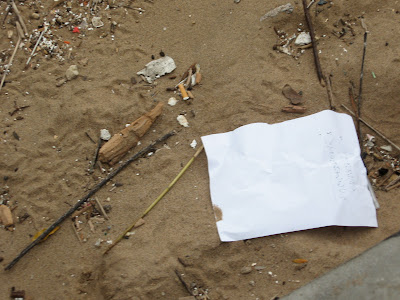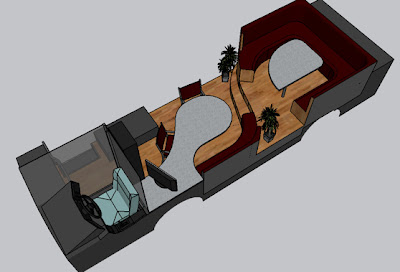Monday, December 14, 2009
Volunteers and Networks
http://www.nyrp.org/Calendar_Programs/Corporate_Volunteer_Program
http://www.nyrp.org/Calendar_Programs/NYRP_Volunteer_Corps/NYRP_Volunteer_Corps_Sign-up
https://www.nyrp.org/Donate_and_Membership/Buy_an_NYC_Tree
These links are the basis for what will be a plan for our base of volunteers/ worker structure.
I still need to map it out officially though. I hope it is okay. I will have it finished for when we see elliot though.
Saturday, December 5, 2009
Quick sketch of how carts park together
Work in progress: project brochure
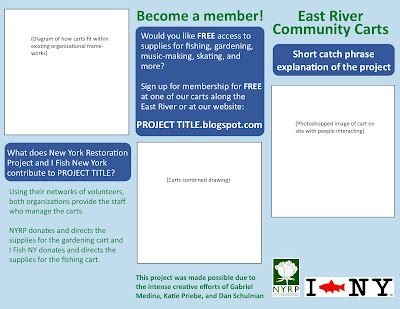
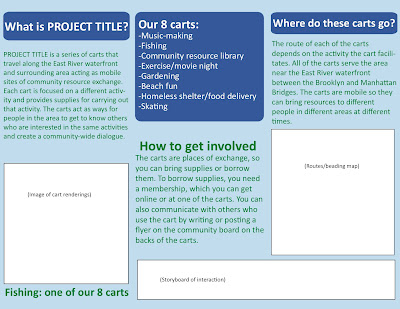
Title!
We need to think of a title for the cart program! Any ideas?
Here is a list of words that we were brainstorming with in class:
waterfront
connections/connected
mobile
East River
carts
sharing
borrowing
beads
bridging/bridges
"community carts: connecting people along the east river waterfront"?
Friday, December 4, 2009
LIST OF THINGS FOR FINAL
List of things to do for FINAL:
1. 3D renderings of template cart with 2 storage views (spaces for fishing and gardening equipment; compartments for storage fold out from interior to exterior/ reference Katie’s drawings on blog for what kinds of things need to be stored, especially garden cart) GABRIEL
2. Beading map of existing fishing and gardening nodes and potential sites (show how they might overlap) GABRIEL
3. Diagram of how carts fit within existing organizational frameworks (volunteers and supplies) DAN
4. Storyboard of how to interact with cart (to go on side of cart), for community audience DAN
5. Storyboard that shows how carts are interacting with community, for jurors KATIE
6. Quick drawing of how the carts combine when closed down and parked GABRIEL, DAN, KATIE
7. Brochure addressing community that explains cart program in general (mission, services/supplies) KATIE
8. Website for presentation (mockup for program) ALL
9. Photoshopped collage of cart drawing on site KATIE
Tuesday, December 1, 2009
Online conversation for Friday's class
"so things to have for Friday:
[1] ongoing conversation > clarity about what their design entails, what needs to be developed
[2] list of drawings [and maybe some completed drawings?]
[3] clear team agenda for working on Friday
[4] individual working definition of public space [4-5 sentences] - please email this to me before Friday am."
Here are my thoughts:
1. Like I said in my email last week, I think we still need to develop the form our 'mobile things' are going to take, as well as the plug-ins. I think we also need to figure out who would be in charge of carrying out these community centers. If we are thinking about having specific organizations, I have done some research related to organizations that could potentially provide volunteers or resources for fishing or gardening activities.
2. I'm not sure what other drawings we would need besides different variations of the mobile thing and plug-ins.
3. Any ideas about what we should do on Friday? Maybe divide up the drawings and each of us could work on their drawing in class. Dan, if you want to do a drawing not on the computer, let me know because I have lots of colored pencils and markers.
4. Public space is an arena where a variety of persons have the freedom to convene for different reasons and with different uses in mind. Because definitions of use are open-ended, public space allows for groups with different interests to intermingle and then create new uses. Public space does not have to be officially designated open space in order to be public; as long as it is free and accessible to anyone and used by a number of people, it is public space.
Thursday, November 26, 2009
Sketches for 'mobile things'


Here are two ideas of how a fishing and gardening cart could be pushed by one person and one idea of how the cart could be 'plugged-in' under the fdr. Basically, it's a little wooden box that locks around the cart, which would be parked in a parking space. The same map that is inside the cart, which shows the route of the cart, would also be posted on one of the nearby poles.
Tuesday, November 17, 2009
Traffic map
Monday, November 16, 2009
Two diagrams

 The first image is a map that shows the drawings that people made for my first paper related spatially on the site as well as their overall mood. The second drawing is a model for my final paper, where I interview current site users to explore existing social networks, which will hopefully lead to a more informed group design.
The first image is a map that shows the drawings that people made for my first paper related spatially on the site as well as their overall mood. The second drawing is a model for my final paper, where I interview current site users to explore existing social networks, which will hopefully lead to a more informed group design.
Thursday, November 12, 2009
Wednesday, November 11, 2009
Monday, November 9, 2009
Narrative...



On weekend afternoons, residents of the smith’s House gather to play percussion by the lower parking lot of the complex. It is like karaoke for percussion instruments. Amplifiers are propped on to carts secured with bungee cords. A sound track is played and musicians improvised their own percussion arrangement. Groups of women gather around them and sporadic dances emerged spontaneously. Another group of men are playing a dominoes tournament right side by side, jokes and comments are exchange between musicians and dominoes players.
The Music truck plugs in a Greek Theater style space that provides intimacy and shelter to the participants. The truck unfolds providing the musicians with amplifying equipment as well as extra instruments for spontaneous musicians that may show up announced. Chairs and tables are also stored for the dominoes players.
A similar truck with very different equipment, for the residents that like to garden, is plugged in near the Manhattan Bridge along side a beading of raised beds that cascades down stream from the heart of the neighborhood. The flowerbeds are use for spontaneous gardening and at the same time they retain runoff water from rainstorms. The truck is equipped with garden utensils, seeds, watering cans, gloves, soil, as well as related literature. Extra general literature is available for those who prefer to relax in a bench by the vegetable and flowerbeds.
Similar trucks plug in along side the East River waterfront providing stimuli to activities such as gardening, music, skate boarding, beach playing. The trucks acts as pollinizers of space.
.
Sunday, November 8, 2009
Individual Observation and Method using Hood
Observations and Analysis
• The beach under the Brooklyn Bridge is a wasteland and dumping ground for litter and unwanted items. This space has a small door making it inaccessible for any person to easily embed themselves in the space or make use of it.
• The track for biking and running is situated right near parking. makes it dangerous for pedestrians and an unlikely path for the elderly or handicapped individuals.
• Visitors are mostly transient. However, there are those that read and sit on the benches.
• Under the F.D.R., there is little to no light coming into the space making it difficult for use unless you sit at the water’s edge near the gate.
How can the bus solve this?• Perhaps the bus can house a ladder/slide to free access constraint to the beach and rent/sign out beach materials and tools.
• By creating a ‘mobile community center’ or a fleet of buses designed for specific uses, it enables for easy transport for these disadvantaged groups to use and experience the space.
• Creating a library and book-swap program on the bus will allow for people to interact and build community.
• Perhaps the bus will have an awning and light fixtures that will illuminate the space when the bus is parked. This energy can be used from solar paneling which absorbs light in the daytime and when the bus brakes for this specific use.
How does this fits with our vision/strategy?• Through different services provided, we will amplify the activities the space is used for while also building community via methods of social interaction. I.e. - Hood’s example of children in the playground not using the physical structure-but digging in the dirt. By designing a space where, perhaps, there will not be a physical structure but more opportunity to amplify an existing use such as the sandbox- it allows for more interaction and community building amongst the children. Climbing is more solitary but the sandbox allows for more fluidity of imagination.
Truck inspiration...
river-front tactic





Better late than never...
Truck inspiration...


As I was telling you about the "kitchen in the closet" at 25 East 13th, 2nd floor. I was designed by Allan Wexler. I particularly enjoy how low key, honest it is. It is also very compact and it rolls as well as unfolding into this very articulated "work-space" as well as "backdrop". I can imagine different trucks according to the particular "node" where it plugs in. Gardening, fishing, etc.
Possible visioning narrative
Saturday, November 7, 2009
Boulder Space:
8 Responses to “Special Transit’s Newest Line - Mobile Meeting Space”
1.
on 07 Aug 2008 at 8:46 am1Barb Borg
What a great, innovative idea! Love the contemporary design. I’m curious- how will it stay cool (air ocnditioned) and lighted- I assume the power will be additional to the bus battery(?).
2.
on 07 Aug 2008 at 3:05 pm2Sandy Sisneros
With winter soon to arrive, what about heating the space? How many people will this accomodate for a meeting? Will the heating/cooling be on an as needed basis or continually running? The design looks very usable. What about diesel fumes?
3.
on 07 Aug 2008 at 8:00 pm3Scottan
Barb,
We anticipate the bus being able to be plugged into the local electrical power supply, or run off of solar panels. The air conditioning will be a small unit with an external vented condenser. We are looking at LED lighting for general and accent lights.
4.
on 07 Aug 2008 at 8:08 pm4Scottan
Sandy,
The bus will have a permanent heating and cooling system.
I would anticipate that it will be conditioned only during its use and potentially setup on a thermostat. Occupant sensors could also be added to maintain lighting and air temperature in the bus as well.
It should be able to cool or heat quickly due to its modest size.
The bus will give off similar fumes as the current HOP buses that operate in the City. We would like to only us the diesel during the periods that the bus is in motion.
5.
on 08 Aug 2008 at 10:01 am5Barb Borg
Thanx for the quick response, Scott- this idea has me looking at buses (planes & trains, et. al) in a whole new way! I’ll look forward to keeping up with the progress. Barb
6.
on 12 Aug 2008 at 7:41 am6Boulderspace - Your Design & Development Resource » Blog Archive » Special Transit’s Bus Transformation - Call to Action
[…] MO.Free (MObile Freedom) continues to flourish, Special Transit (ST) is excited to unwrap some of […]
7.
on 12 Aug 2008 at 12:52 pm7Laura Page
This is a wonderful idea! What is the expressed greatest need for overflow space? The design presented looks to me more like an accessory office for one or two people plus a cozy area for two or three people to meet.
If, on the other hand, the bus’ most likely use will be for a group of people to come together for a meeting or presentation, a design that is more “round table” might be more appropriate. It would be a lot less “sexy” but perhaps more useable. If the design were more for a circle of people, the seating would be around the perimeter but ease of access would prevent a table in the middle. Perhaps chairs could be fixed to the walls with extensions that swing up for a writing surface. That would also ensure all the furniture was secured while the bus was on the road, something that needs to be addressed with the current conceptual design.
Though the space is small, the cooling needs will be great. The bus is essentially a tin can with no insulation. It transmits a tremendous amount of heat if sitting in the sun in the summer. It is also hard to keep warm in the winter. Equipment left on the bus when not in use will have to endure great temperature extremes.
Audiovisual presentations are common at meetings. To be successful, the bus will need to be darkened. Perhaps a window shade that runs the length of the windows could be stored in a tube on the outside of the bus. For darkening, the shade could be pulled straight down over the windows. When the bus doesn’t need to be darkened, the shade could project out from the bus, over the top of the windows, to shade the windows from direct solar gain.
Good luck with your project!
8.
on 12 Aug 2008 at 7:37 pm8Scottan
Laura,
Thanks for your extensive comments. You sound like you might be in the architecture/engineering/construction community?
In general MO.Free will be used as an overflow space for 5-10 people. The design currently has a step up in the back which would allow for a “stadium” feel to the space.
As MO.Free evolves we are advocating for people to pass the word. Updates will continue to be posted and, a
“lets build this” roundtable will also be held. Stay tuned to BoulderSpace.org
We have discussed constructing a place for MO.Free to be parked when it is not on the move. A freestanding “carport” with solar panels could provide energy + provide shading.
Design that makes a difference……
Fun and Interesting Facts
So what is interesting is if you look at this map:
http://www.nytimes.com/interactive/2009/11/04/nyregion/mayor-vote.html?ref=nyregion
You can see that residents around the East River Waterfront- specifically around our portion of the site voted for Thompson and not Bloomberg- perhaps it has something to do with Planyc and the development plans?
This could have some tie to our research about the people we would be focusing on with our intervention.
Thought you might find it interesting.
-Dan
Thursday, November 5, 2009
Tuesday, November 3, 2009
Examples of similar mobile community center projects
Group tactics!
Monday, November 2, 2009
Tactics
Truck/Bus/Trailer with equipment, books, fishing gear rental
2)Filtered water pool/separated beach within East river for clean beach access
3)cleansing/filtering system for healthier fish for Fisherman
4) Assemble your own Kayak/Boat area program
5) Under the FDR fish tank/ecosystem that provides an understanding of what the sealife is at the east river and the harmful effects of cso overflow are.
Sunday, November 1, 2009
Gabriel's Tactics
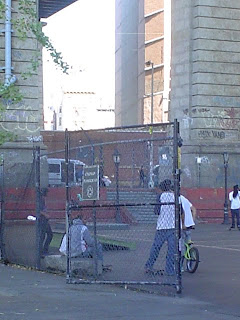







Tactic 1: Erosion and Sedimentation
Intervention outcome


